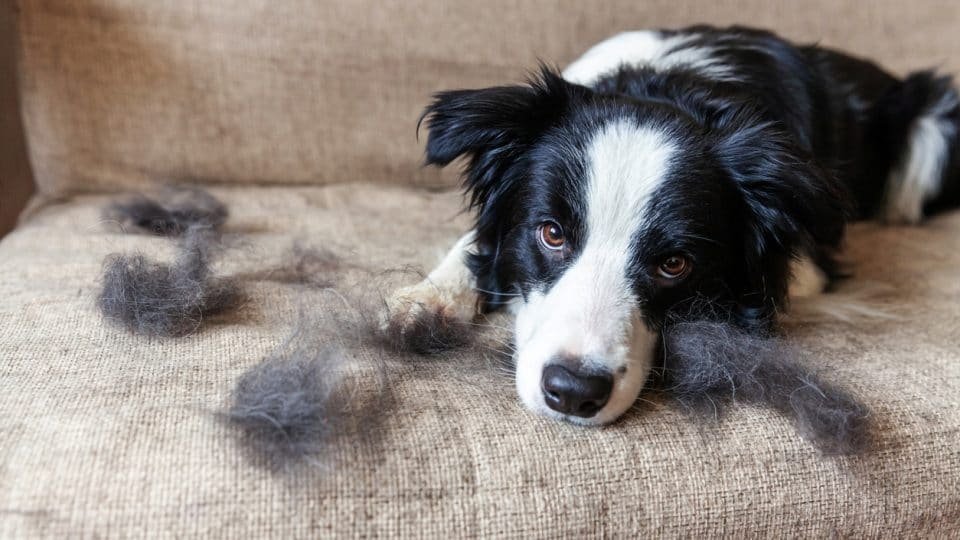Why Is My Dog Shedding So Much?
Love your dog but frustrated by all the fur they leave behind? Dogs naturally shed their fur as part of their hair’s growth cycle. Certain dog breeds that shed the most, like Golden Retrievers, Labrador Retrievers, and German Shepherds, are more prone to shedding than others because of their double coats. You might also notice your dog sheds more in the spring and fall, that’s because they’re shedding their old fur to make way for a new coat. A poor diet lacking essential nutrients can also lead to excessive shedding. Underlying health conditions like allergies, hormonal imbalances, or parasites can also cause increased shedding.
Start With A Brush
Regular brushing can help remove loose fur and reduce shedding. Choose a brush suitable for your dog's coat type and brush in the direction of hair growth. You could also consider using a shedding blade, a special tool that can help remove loose fur from your dog's coat.
Take It To The Tub
Bathe your dog using a gentle, moisturizing shampoo specifically formulated for dogs to maintain a healthy coat and reduce dryness, which can contribute to excessive shedding
Check The Food
A healthy diet can help improve the condition of your dog's coat and reduce shedding. Ensure your dog is getting all the necessary nutrients, and you’re not overfeeding. Look for dog foods with omega-3 and omega-6 fatty acids, which promote a healthy coat. Consider adding supplements like fish oil or omega-3 fatty acids to your dog's diet, as they can help improve the condition of the skin and coat, reducing shedding.
Scenthound’s Specialized Care
Scenthound's Shedding Treatment is a revolutionary solution designed to combat excessive shedding in dogs. This specialized treatment utilizes advanced techniques to reduce shedding by up to 90%, leaving your dog's coat healthier and your home cleaner. The Shedding Treatment involves a combination of specialized products and expert grooming techniques. It includes a deep cleansing shampoo to remove excess fur and debris, followed by a nourishing conditioner that promotes a healthy coat and minimizes shedding. The treatment also includes a thorough brushing using specialized shedding tools to remove loose fur effectively. This process reduces shedding and helps maintain a well-groomed appearance for your furry friend.
Regular Check-ups
Schedule regular visits to your veterinarian to rule out any underlying health conditions that may be causing excessive shedding. They can thoroughly examine, conduct relevant tests, and provide any necessary treatment.
Frequently Asked Questions (FAQs)
Q: Why is my dog shedding so much?
A: Excessive shedding in dogs can be attributed to breed traits, seasonal changes, and underlying health conditions. Identifying the cause is essential in addressing the issue.
Q: How can I reduce my dog's shedding?
A: To reduce shedding, focus on providing a high-quality diet, incorporating supplements like omega-3 fatty acids, establishing a regular grooming routine, brushing and bathing, and considering specialized shedding treatments like Scenthound's Shedding Treatment.
Q: What breeds of dogs shed the most?
A: Breeds such as Golden Retrievers, Labrador Retrievers, and German Shepherds are known for shedding heavily due to their double coats. However, shedding can vary among individuals, even within the same breed.
Q: How does Scenthound's Shedding Treatment work?
A: Scenthound's Shedding Treatment is designed to reduce shedding by up to 90% significantly. It combines specialized products, deep cleansing, nourishing conditioning, and expert brushing techniques to remove loose fur and promote a healthier coat effectively.
Q: Should I be concerned about my dog's excessive shedding?
A: While shedding is natural, excessive shedding may indicate an underlying issue. It is advisable to consult a veterinarian to rule out any possible health conditions causing the excessive shedding and determine the best course of action.

